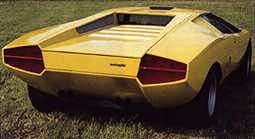Concept
From the first day Ferruccio Lamborghini decided to establish his own sports car factory, the only idea in hismind was: knock down Ferrari ! Within 3 years, he did that with Miura, a mid-engined V12 supercar with beautiful look and incomparable speed.
Having fulfilled the original
goal, his next dream was to create an all-time greatest supercar. That
car should be
unbounded by any existing
rules, should be so outstanding that no word could describe its excellence.
Therefore he named this car "Countach", an Italian word simply meaning
"Wow ! Look at this !".
Miura, the fastest car in the world then, could run up to 172 mph. Countach, on the other hand, aimed at 200 mph. Yes, it was TWO HUNDRED MPH. Besides, it should have an appearance that could stun everybody. Having these 2 basic goals in his mind, Ferruccio Lamborghini ordered his engineering team to start the project.
Development
Countach was developed under the leadership of chief engineer Paolo Stanzani, although some technical background came from Miura, which was penned by Giampaolo Dallara (the famous chassis expert for Formula 3).From the beginning, Stanzani
chose the most advanced technology available (most expensive, too) without
the slightest hesitation, these included:
- Mid-engined
- V12 engine with 4 camshafts
- Space frame chassis
- Aluminium body
At nearly the same time, Bertone studio was chosen to responsible for the styling. Very lucky, Nuccio Bertone had already recruited a young and ingenious designer, Marcello Gandini. This man created a really stunning design for Countach. Without installing an engine, the so-called "Countach LP500" prototype was unveiled in Geneva motor show 1971 and immediately became the star of the show.
 |
 |
When Lamborghini showed the car again in the 1973 Geneva show, it was very much closer to production. Next year's Geneva show displayed a real production Countach, now called LP400 because it adopted V12 displacing roughly 4 litres instead of the originally proposed 5 litres. The bigger engine was discarded because of technical difficulties.
In April 1974, the first Countach was delivered to a customer in Milan.
 |
 |